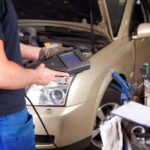Understanding the intricacies of modern vehicles often begins with grasping the diagnostic protocols that enable communication with a car’s complex systems. Among these, Kwp2000 Obd2 stand out as crucial for anyone involved in automotive repair, diagnostics, or ECU modification. This article delves into these protocols, highlighting their features, differences, and significance in the landscape of vehicle diagnostics.
On-Board Diagnostics (OBD2): The Foundation of Vehicle Communication
OBD2, short for On-Board Diagnostics II, is a standardized protocol mandated for all vehicles manufactured from 2002 onwards. It serves as the fundamental layer for accessing vehicle sensor data, reading and clearing Diagnostic Trouble Codes (DTCs), and retrieving basic vehicle information. Designed with simplicity and safety in mind, OBD2 primarily focuses on reading data and does not support writing or modifying ECU parameters. This makes it a safe entry point for basic vehicle health checks and emissions testing.
Alt text: Example of an OBD2 port in a vehicle, the standard interface for accessing diagnostic information.
Keyword Protocol 2000 (KWP2000): Advanced Diagnostics and ECU Interaction
Keyword Protocol 2000, or KWP2000 (ISO14230), represents a more advanced diagnostic protocol widely adopted by vehicle manufacturers between 2000 and 2006, before being largely superseded by UDS. Unlike the read-only nature of OBD2, KWP2000 facilitates complex bidirectional communication, allowing for a broader range of operations. This enhanced capability, however, comes with the responsibility of careful usage, as incorrect application of KWP2000 can potentially harm vehicle systems.
KWP2000 unlocks functionalities far beyond the scope of OBD2, including:
- ECU Flashing: Reprogramming the Engine Control Unit (ECU) with updated software or custom tunes.
- Permanent DTC Management: Reading and clearing DTCs that are persistently stored in the ECU’s memory.
- Communication Parameter Adjustment: Modifying ECU communication settings for specific diagnostic or testing needs.
- Low-Level Memory Access: Interacting directly with the ECU’s EEPROM or RAM for advanced modifications or data extraction.
- Gateway Access: Navigating vehicle networks with gateway modules to reach specific ECUs behind the gateway.
The KWP2000 specification implemented widely is version 2.2, dated 2002, showcasing its maturity and established presence in automotive diagnostics.
Alt text: Illustration of an ECU diagnostic interface, highlighting the connection point for protocols like KWP2000.
KWP2000 vs OBD2: Key Differences and Applications
While both KWP2000 and OBD2 are diagnostic protocols, they cater to different levels of diagnostic needs. OBD2 serves as the standardized baseline for emissions-related diagnostics and basic vehicle health monitoring. Its primary advantage lies in its simplicity and universal adoption, making it accessible for basic code reading and sensor data retrieval across virtually all modern vehicles.
KWP2000, on the other hand, is designed for in-depth diagnostics and ECU manipulation. It is favored in professional automotive repair settings and by enthusiasts who require advanced control over vehicle systems, such as ECU tuning or complex troubleshooting. The enhanced capabilities of KWP2000 make it indispensable for tasks that go beyond basic diagnostics, but also necessitate a higher level of expertise and caution.
Conclusion: Mastering KWP2000 OBD2 for Comprehensive Vehicle Diagnostics
For professionals and enthusiasts in the automotive field, understanding KWP2000 OBD2 is paramount. OBD2 provides essential access for standardized diagnostics, while KWP2000 unlocks advanced functionalities for deeper system analysis and ECU modifications. Recognizing the strengths and limitations of each protocol is crucial for effective vehicle diagnostics and repair in today’s automotive landscape. As diagnostic technology evolves, familiarity with both KWP2000 and OBD2 remains a valuable asset in navigating the complexities of modern vehicle systems.
